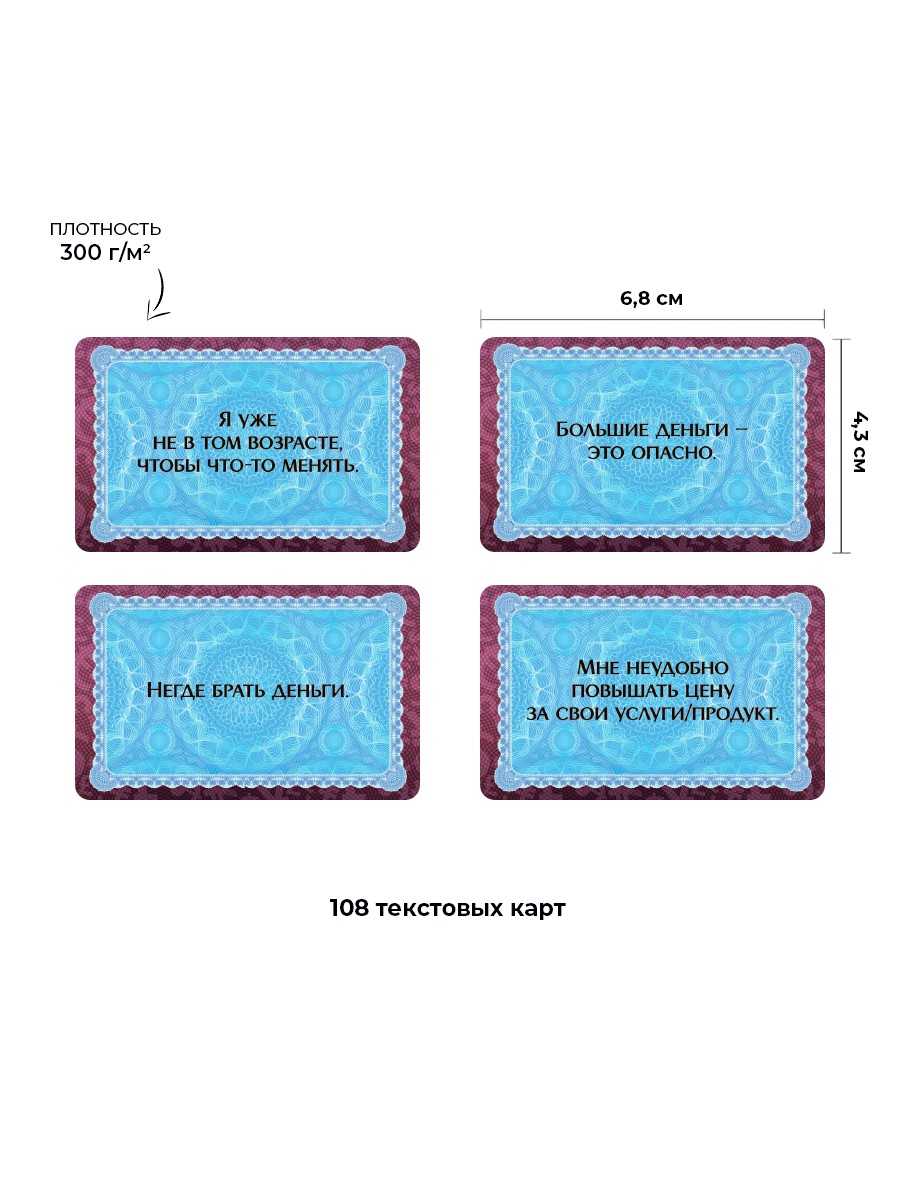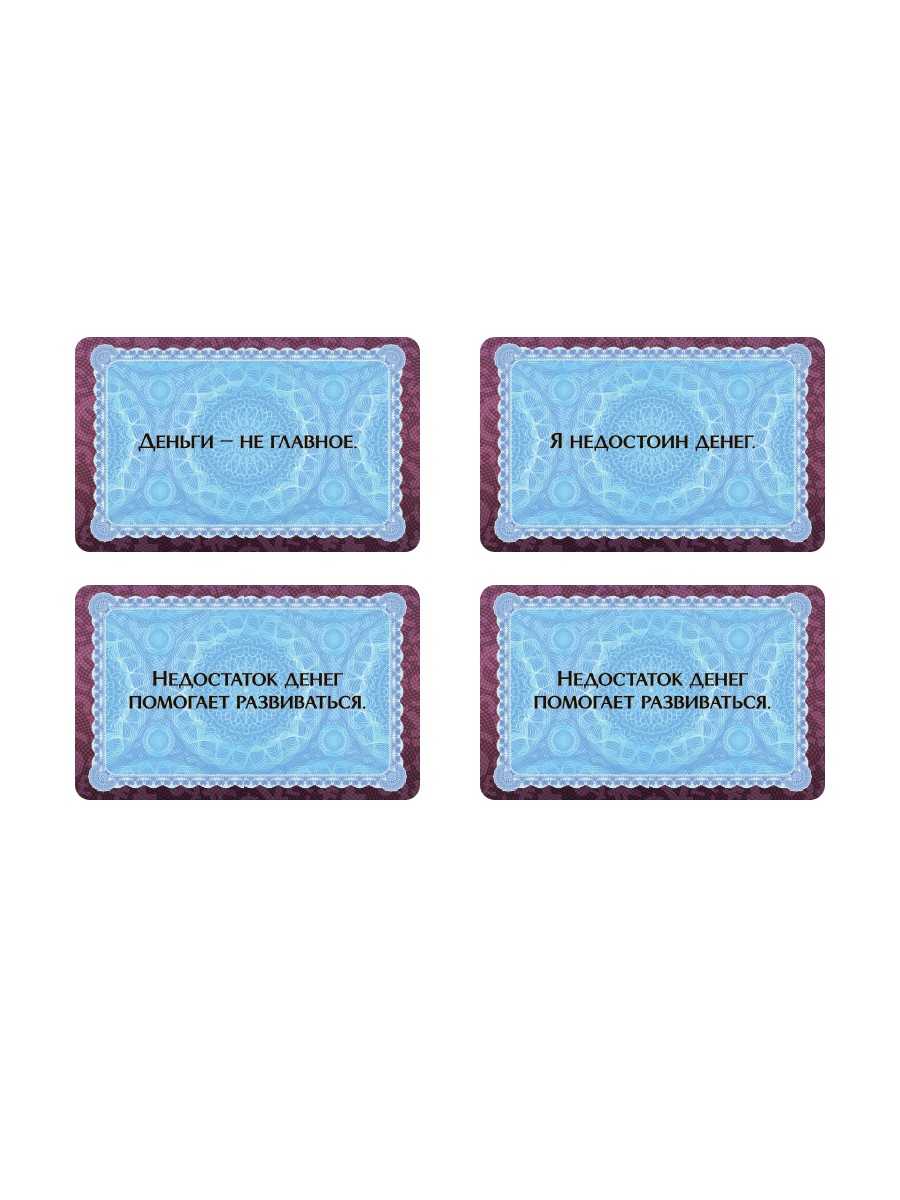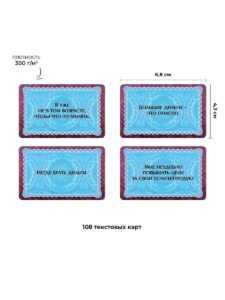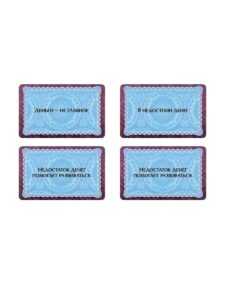Included in the kit for working with money requests.
Author: Evgenia Baksan
Publisher: MACards
Contents:
- 100 cards (common limiting beliefs, destructive attitudes about money and material well-being),
- Instructions with work techniques.
Beliefs are internal attitudes, thinking patterns into which a person believes as if it were true.nbsp; This is a generalization of his life experience about how everything works in this world and what is connected to what. In his decisions, actions and inactions, he considers them as rules and absolute truth. They make his world simple and understandable.nbsp;In every area of life we have a certain set of beliefs, which can be constructive, supportive, effective and helpful, or destructive, limiting and prevent us from achieving what we want.nbsp;The system of these beliefs, the program –< em>nbsp; as a “filter” through which we see the world. And this worldview – the “picture of the world” – determines and shapes reality. For the subconscious, what we believe in is possible.
Attitudes can be conscious, explicit (a person pronounces them, repeats them, like a proverb), and hidden (a person is not aware of them, but lives in accordance with them). And if they interfere, it is important to get rid of them.nbsp;By analyzing your speech, thoughts and actions, and what happens and repeats in life, you can identify negative attitudes and your scenario.nbsp;Beliefs are formed and approved throughout life, starting with childhood. Based on the beliefs of parents and other significant adults, your own repeated experience, the experience of authoritative people, or something that very emotionally shocked a person…
Limiting beliefs on the topic of material well-being shape the attitude towards money, towards the owners of money and towards the world; influence behavior and plans. These beliefs carry a negative message and limit life, freedom of choice, desires and actions and lead to dissatisfaction.nbsp;Changing these attitudes is a very important step in working with money requests.nbsp;Attitudes are our choice, and, if necessary, they can be changed.
“Tomorrow you will see the results of what you think about today” – quote.
An approximate general algorithm for changing limiting beliefs to supportive, helping ones:
- Identify and become aware of your beliefs that are interfering
- Understand what impact they have on life, and what the consequences will be if nothing is done
- Question a belief, “sow” a thought in yourself, what could be different. Think adequately and whether it is relevant now
- Reformulate the belief in writing into one that will help. “Transform” it so that it sounds constructive and responsive
- Learn a new belief over a long period of time through repeated repetition and positive reinforcement(for example, a screensaver on your phone that resembles a recording that is always in sight; speaking or writing affirmations; positive emotions while speaking a new belief, confirming that it works in your life, examples of others…)
Techniques for working with text cards “Limiting Beliefs”
– When working with beliefs, you can make a choice of thematic text cards both openly (consciously, face down) and closed (without looking, face down). It is effective to combine these two methods, making a choice open-up, and then supplementing with several cards that were taken face-down.
– The cards with statements you choose can completely repeat your attitude word for word, or reflect its essence. It is important that it has meaning for you and responds emotionally.
– All work is recommended to be done in writing.
Some techniques from the instructions:
MIRROR technique
From the deck ” “Limiting Beliefs” openly select all the beliefs that in your opinion most influence the area of money in your life.
Now take a closer look at them and think about what they reflect in you, what message do they convey? And categorize: Non-compliance with moral and spiritual values; Despair and hopelessness; Helplessness and impotence; Fear; Low self-esteem; Other.
Analyze each category, what else is behind it? What do you need to work on? What is this about for you? (For example, behind the statement “I can’t change anything,” which speaks of my despair and powerlessness, there is another belief that “I won’t succeed.” I’ve had this since childhood, when I was told that I stupid, and “my hands don’t grow from there.” And also, I became convinced of this later, when I made mistakes, that I can’t do anything.
For me, it’s about the fear of making mistakes. puts me into a stupor, leads me to remain inactive so as not to suffer defeat, or, if I have to act, I cannot mobilize out of fear, act ineffectively and make mistakes. In any case, I should not be so critical of mistakes. Mistakes are experience, and it’s okay to make mistakes. I’d rather believe that “He who doesn’t do anything makes no mistakes, I’ll give myself the right to make mistakes, I’ll allow myself to do something less than perfectly, thinking not only about the result, but also.” enjoying the process. And then I will have a chance to change something).
TECHNIQUE “RESEARCH AND TRANSFORMATION”
- Where did you get this installation? How did you know that this was so?
- Where and from whom did you hear it? Whose voice does she sound in (father, mother, grandmother or grandfather, other significant person)? Why did they think so? (For example, my grandmother always said, “Money is dangerous.” Perhaps she was so afraid of it because she experienced “dekulakization” with her family).
- What in your life is her confirmed? Why do you think? Could this belief have turned on an “inner defense” against money, and you were unconsciously acting out ways of not having it? Could your inner part and scenario attract these situations?
- Why do you believe this now? Is this 100% true and relevant?
- How do you act on the attitude?
- How long have you lived with it?
- What would your life be like if continue to believe in it? What do you have to lose? Isn’t the price too high?
- Can you imagine that it could be different? Can you question this attitude?
- What examples do other people have in their lives that confirm that this may not be the case?
< br>
- How does this attitude affect you and limit you in life?
- Formulate an opposite, supportive belief, but in such a way that it suits you and is safe at this stage, resourceful, and you could begin to believe in it. Start formulating it gradually. Not just – “Money is safe,” since you are unlikely to believe it, and perhaps there is some protection in it that is important to consider, but without exaggeration and fanaticism. Try adding the word “illusion” or “distortion” to the belief first. (For example, “I have a cognitive distortion that money is dangerous.” But everything is conditional, and in fact I can replace this belief with “If I manage money wisely, it is safe”)
- What other beliefs have you had in your life that have changed to constructive ones? Do you feel that it is realistic to change your attitudes?
- What percentage do you now believe in your new belief? Do you like this idea? How will your life change if you follow it?
- What needs to be done for it to take hold and become a new truth for you?
“INFLUENCE” technique
- What feelings does it evoke in you, what sensations in your body?
- What do you want to do then?
- B What are the advantages and benefits of this belief? What does it protect from? What benefits did it bring? What should you consider and what should you reconsider?
- What is the cost of this? What influence does it have on your life, in what ways does it limit you?
- Where did this belief come from? Where and from whom did you hear it? What events and situations had an impact?
- What will happen if nothing changes? What will your life be like? Is this belief worth it?
- What should the new belief be so that it will be different, as you want?(For example: “Even though there is no money, but I am kind”, you can change it to “Wealth will give the opportunity to do more good”).
(For complex work and increase efficiency, the tool can be combined with a set of metaphorical associative and thematic cards: “Money request”).























Reviews
Clear filtersThere are no reviews yet.